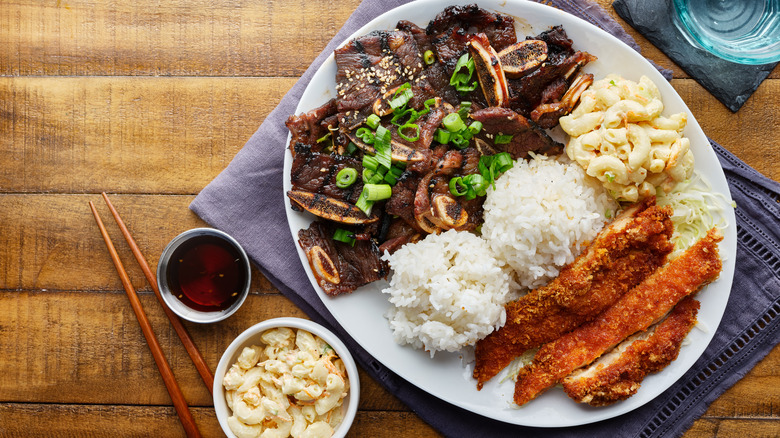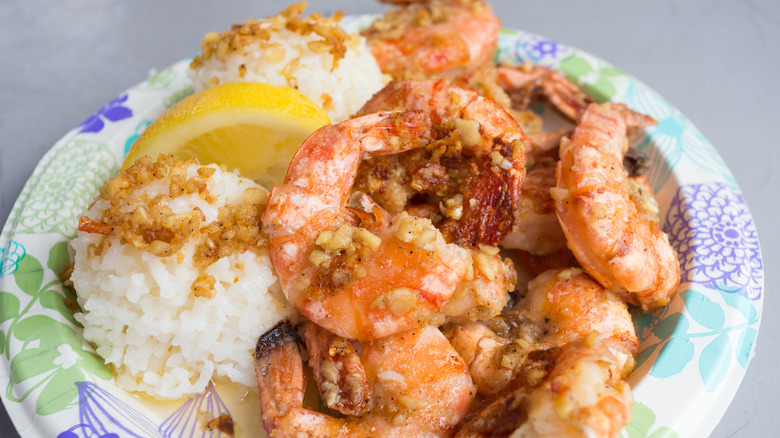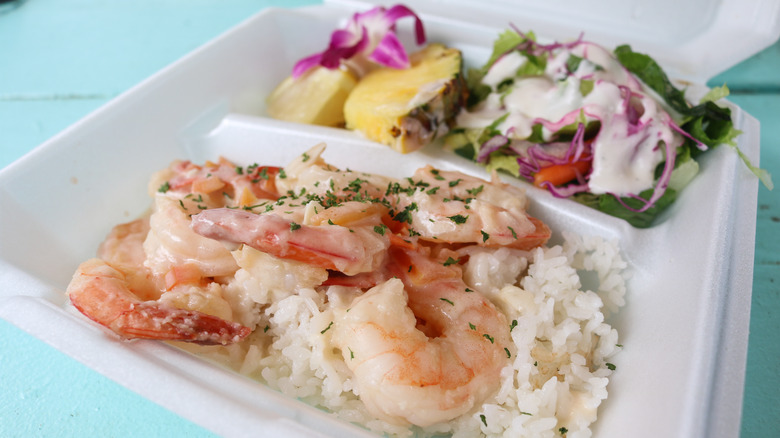The Origin Of Hawaii's Most Popular Meal
Each state has its own iconic dish. Arizona has its chimichangas, Colorado, its lamb chops, and Minnesota, its hotdish, per Taste of Home. And while different people might have different ideas about what Hawaii's culinary "thing" might be — spam musubi, anyone? — the plate lunch could well be the island meal that rules them all. The plate lunch is so iconic that former President Obama was said to have asked for it on a visit back to the islands, per The Mercury News.
The plate lunch is not for the faint of heart, nor for someone who doesn't have a sworn love affair with carbohydrates. The New York Times describes the "foundation" of a plate lunch as two servings of white rice and a side of mayonnaise-heavy macaroni salad. To that is added different types of proteins cooked in a variety of styles that reflect the cultural mix that is Hawaii's local population, whether it is Korean kalbi or barbecued beef short ribs, Chinese-style roast pork or char siu, Philippine adobo, Japanese chicken katsu, or even a loco moco — which is a grilled beef patty over rice with a fried over-easy egg on top and brown gravy on the side (via Hawaii Magazine).
The plate lunch goes back to the days Hawaii was filled with plantations
The treat that's found at most Hawaiian eateries for a song has been around for a while — even longer than the Rainbow Drive-In, which opened in 1961, per The Mercury News, and which counts former President Obama as a fan. Eater traces the origins of the plate lunch to the days when fruit plantations were the key drivers of Hawaii's economy and its workers came from different parts of the world.
The Honolulu Advertiser's former food editor, Kaui Philpotts, tells The New York Times that the workers would use the small tins to hold their bento. The meal contained leftover rice and a lot of items like teriyaki sauce, cold pork, canned meat, eggs, and pickles, with hardly any salad or vegetables. It's believed rice was a part of the plate lunch from the get-go, but the mac salad didn't come until after.
Even after the plantations began closing down, the plate lunch endured. As per Eater, the distinctive meals were being served out of lunch trucks during the 1930s, and by the 1950s, the dish was offered at restaurants around the island.
The plate lunch has a healthy version
Today, The New York Times says the plate lunch has evolved yet again so it can be adapted to suit the health-conscious diner. For example, instead of white rice, there is brown, and in place of the mac salad, there is a healthier salad alternative. With that, plate lunch enthusiasts can enjoy a selection of toppings, and among the favorites, per Hawaii Magazine, is the laulau (pork, chicken, beef, or fish wrapped in ti leaves), the Japanese-inspired deep-fried and breaded chicken katsu, the loco moco, the raw poke, and Kalua pig — pork cooked in an underground oven. All of which, as Migrationology points out, makes for the ideal seaside treat.
Philpotts tells The New York Times that while the original plate lunches will always have their critics, more so if they enjoy food or are health concerned. But she doesn't think the sentiment will sway locals — like Obama — who she says grew up eating that meal.


